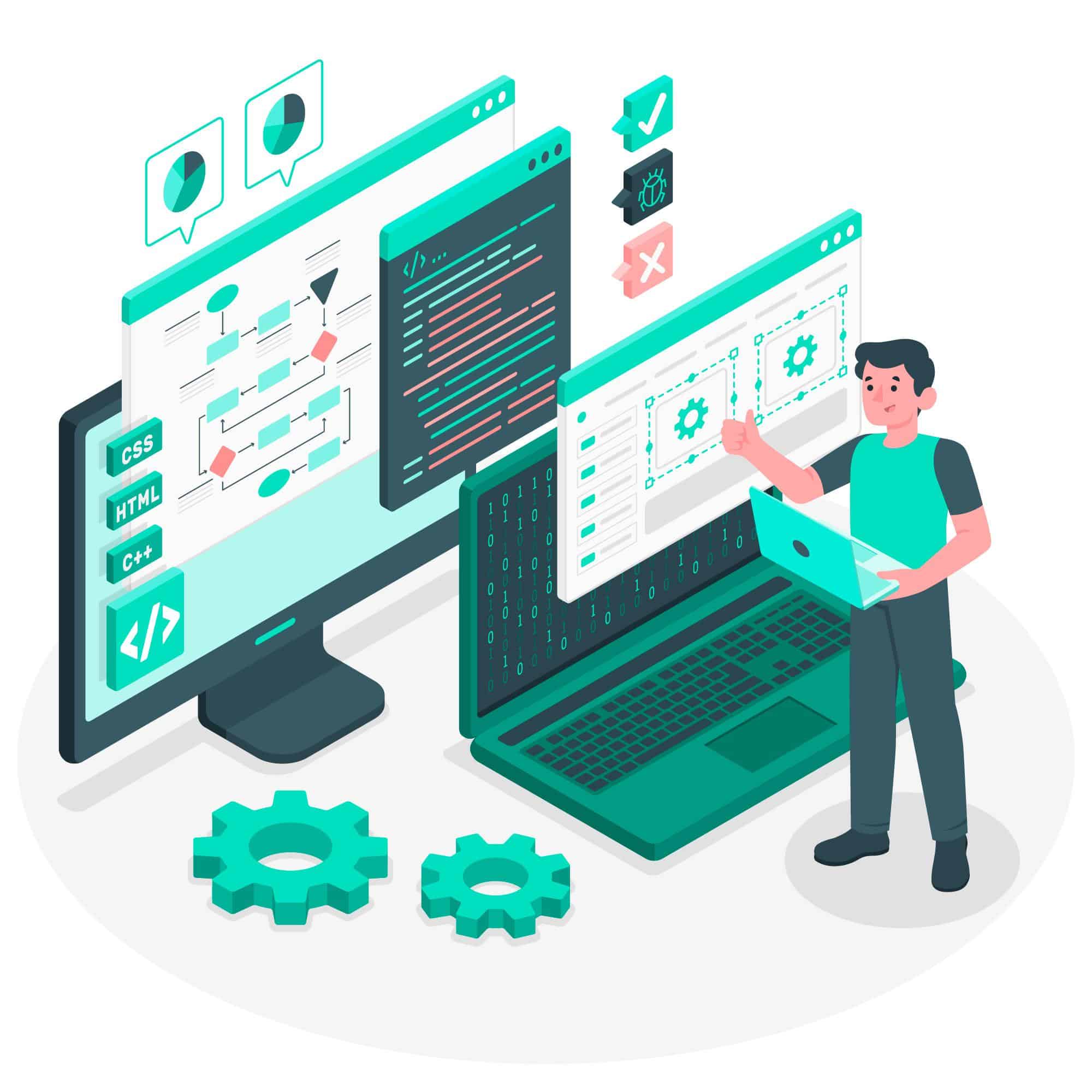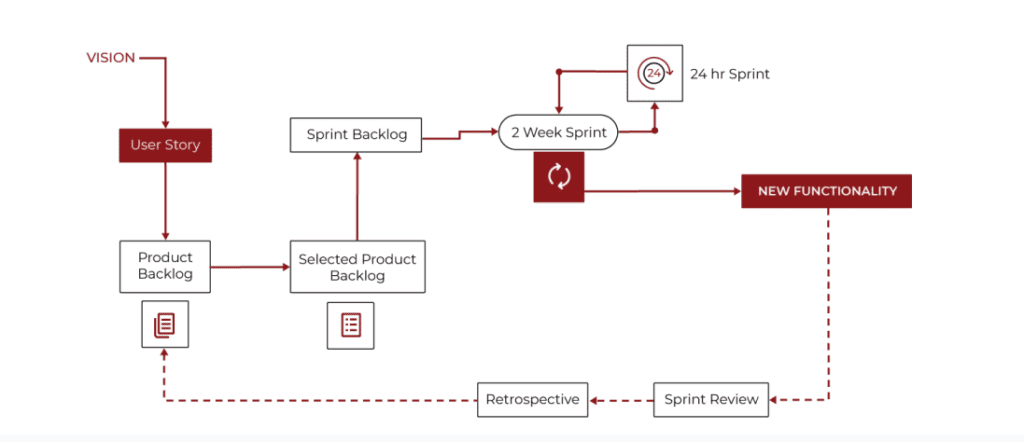
In today’s fast-paced and dynamic business environment, traditional software development methods, such as waterfall, often fall short of meeting the ever-changing needs and expectations of customers. This is where agile methodology shines. Agile development offers a transformative approach to software development that prioritizes iterative feedback cadence, flexibility, collaboration, and end-user engagement in the full project cycle.
Explore the core principles and challenges of agile development and discover how Mantrax is using Agile Methodology to revolutionize software solutions.
Core Principals of Agile Methodology
Iterative and Incremental Approach
Traditional software development methods typically follow a linear, waterfall approach. Instead, agile development adopts an iterative and incremental approach. This means that the software is developed in small, manageable increments or iterations, with each iteration building upon the previous one. This approach allows for faster feedback, ensures alignment with customer requirements, and provides the opportunity to incorporate changes or adjustments along the way.
Customer Collaboration
Agile development promotes close collaboration between development teams and customers throughout the development process. Unlike traditional methods where customers are often involved only during the requirements-gathering phase or at project completion, agile development encourages ongoing customer engagement. By involving customers throughout the process, teams can gather valuable insights, validate assumptions, and ensure that the software solution meets their evolving needs and expectations.
Emphasis on Working Software
Agile development places a strong emphasis on delivering working software in short, regular iterations. Typically 2-week intervals (these intervals are called “sprints”). Unlike traditional approaches that may delay delivering a usable product until the end of the development cycle, agile development ensures that software is continuously developed, tested, and delivered. This approach enables faster feedback loops and empowers customers to see tangible progress, make informed decisions, and provide valuable input.
Flexibility, Adaptability and Risk Management
Agile development promotes flexibility and adaptability. Continuous planning, testing, and improvement are integral components of the agile development process. This iterative nature allows teams to incorporate changes and refine their approach based on customer feedback and evolving priorities. Ensuring that the end product is better aligned with customer expectations and market demands. The continuous planning process also helps with managing the project budget.
Cross-Functional Teams
Agile development teams are cross-functional, meaning they bring together individuals with diverse skills and expertise necessary to deliver the software solution. Agile development fosters collaboration, knowledge sharing, and a more holistic view of the development process. By leveraging collective strengths, teams can overcome challenges more effectively, identify innovative solutions, and achieve higher levels of productivity and efficiency.
Continuous Integration and Delivery
Teams are able to frequently integrate code changes and deliver new functionality to users when working with Agile. This approach ensures feedback is gathered early and often, facilitating faster bug detection and resolution. It also allows for more frequent updates, enabling the software to keep pace with changing requirements and providing customers with added value and competitive advantage.
The above core principles come together to run an agile project. Check out this layout below:
- Sprint: Our project deliverables are organized into manageable intervals known as sprints, typically spanning two weeks.
- Sprint Planning: At the beginning of each sprint, we identify the deliverable and each project team member records their tasks and estimated effort required to accomplish the deliverables.
- Daily Scrum: Our team conducts a brief 10-15 minute daily scrum where each member shares three critical updates:
- Progress made on tasks from the previous day.
- Planned tasks for the current day.
- Any roadblocks or obstacles encountered.
- Sprint Retrospective: At the conclusion of each sprint, we hold a product demo and feedback session. This is an excellent opportunity for the product owner to provide their valuable input. The feedback can be incorporated into the next sprint planning session depending on the severity.
- During the sprint retrospective, we reflect on the team’s successes and areas for improvement. We encourage suggestions for enhancements and acknowledge team members’ contributions.

Factors To Consider When Adopting Agile Methodology From Traditional Waterfall Methodologies
At Mantrax, every project is managed using agile development. Our goal is to provide customers with constant visibility and engagement while keeping our team alert and accountable to ensure we hit deliverables.
While agile development brings numerous benefits, it takes time to learn and adopt this methodology if teams are used to waterfall or other project delivery methods. Here are some proactive tips to overcome these challenges and foster an agile culture within the organization.
Start With a Strong Management Buy-in
Early and positive engagement from management on agile methodologies is a great way to increase engagement. Management can help communicate the positive impact on customer satisfaction and business outcomes, such as reduced risk, better transparency on product development and budget management.
Management can also outline a transition plan to help with adoption, so project teams feel they have time to learn and adopt the tool. Transitioning to a new methodology, delivering on projects and trying to capitalize on the benefits of agile immediately can be intimidating. Addressing this upfront by communicating that new initiatives take practice and put in reasonable benchmarks on training and roadmap to adopting agile.
Invest in Training in Agile Methodology Early
Initial training with practical examples can be a great way to educate all the stakeholders. Continuous learning and agile certifications are also helpful in enhancing knowledge and staying up to speed with developments in the agile framework.
Set Expectations on Product Roadmap
Clients love agile, as they get to see and test functionality early in the project. Early access to product functionality can spark new ideas, which can easily lead to scope creep. To help manage this, set clear projects with goals and priorities. Regularly reviewing and prioritizing project requirements, maintaining open communication with stakeholders and employing agile techniques can help manage scope and excite clients toward future product roadmaps.
Use Adaptive Communication Strategies
Agile development can be particularly challenging for distributed teams that cannot collaborate in person. Leveraging collaboration tools, establishing clear communication protocols, and ensuring all team members have access to necessary information and resources are essential to overcome these challenges. Regular virtual meetings, video conferences, and asynchronous communication channels can foster effective collaboration and alignment within distributed teams.
Bake in Sufficient QA Time
Agile development’s emphasis on speed and quick iterations can sometimes lead to a focus on speed at the expense of quality. To maintain a balance, it is crucial to prioritize quality throughout the development process. Implementing automated testing tools, conducting regular code reviews, and continuously improving development practices can help ensure that speed and quality go hand in hand.
Increasing Productivity Through Agile Methodology
Agile development methodologies offer numerous benefits that contribute to increased productivity and cost savings for organizations. By prioritizing rapid iteration and continuous delivery, agile development enables teams to bring software products to market faster.
Agile development methods allow teams to quickly adapt to changing requirements and market conditions. This flexibility helps organizations avoid costly delays and rework that can occur when using more rigid development approaches. With continuous feedback and improvement, teams can detect and address issues early in the development process.
Agile development’s emphasis on collaboration and communication within cross-functional teams fosters more efficient and effective development practices. By reducing waste, such as unnecessary documentation, redundant processes, and idle time, organizations can achieve higher levels of productivity and decrease costs.
All of Mantrax’s teams use Agile Methodology in all of our projects. By implementing Agile Methodology, Mantrax is able to work closely with our clients and deliver the very best software solutions that meet all of our client’s needs in a timely manner. If you’re looking to get started on a new project and want to work with leaders in Software Solutions and Agile Methodology, then book a discovery call with Mantrax today.




